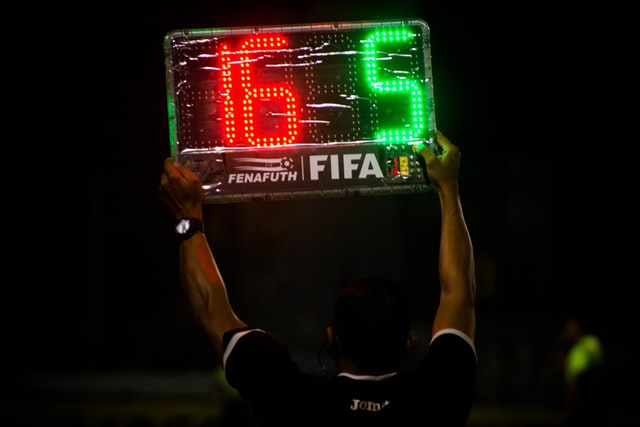If you’ve just started tuning into soccer matches, you might have noticed that they’re not structured like many other American sports.
Soccer’s structure has been largely unchanged for centuries, with some minor tweaks here and there over the years.
With this in mind, we introduce you to how soccer matches are structured around the world today, and what you need to know to ensure you understand what’s happening in front of you!
Are there quarters in soccer?
No, soccer isn’t played in quarters. Rather, the game is played in two equal halves (which is often why it is called a game of two halves!). In the professional game, both halves have to be 45 minutes long, and the referee is able to add additional time in case of stoppages and injuries. Let’s dive a little deeper into the structure of soccer matches below.
The basic structure of soccer matches
At the professional level of the game, soccer matches run for ninety minutes and are split into two halves of 45 minutes. Sandwiched between the halves is a fifteen-minute period known as half-time.
In a standard game of soccer, the referee is entitled to add as many minutes to the first and second halves as he or she likes, depending on what happened during each half.
So, if there were injuries, lots of stoppages, or multiple substitutions, the referee would take all of these into account and add the time to the halves accordingly.
In most matches, the additional period at the end of each half is no more than five minutes, but one match in the English Football League Cup had a total of 28 minutes of stoppage time after a power outage stopped play!
So, to recap, a soccer match is split into two halves of 45 minutes and the referee can add as much time as he or she sees fit. Simple enough? Here’s where things get a little more complex!
Keen to learn more about the structure of soccer matches? Read our piece on how long a soccer game is to top up your knowledge!
How is extra time different from stoppage time?
Stoppage time is the amount of time the referee decides to add on to account for, you guessed it, stoppages in the match! There are a whole number of reasons why the referee might decide to stop the game, but the most common include:
- Injuries to players
- Substitutions
- Issues with the ball
- Spectator problems (pitch invasions)
- Technical issues
- Weather related problems
The referee stops the watch when an issue arises, and the time is added on at the end of the half.
Extra time, on the other hand, is a defined period that might be added to a game, depending on the rules of the competition. In league matches, periods of extra time are not required, as a tie is a legal outcome of the game.
However, in knock-out competitions where one team has to win, a period of extra time is played to give both teams the opportunity to try and win the match.
The period of extra time played is thirty minutes, split into two halves of fifteen minutes. There is no half-time break in between extra time, with the players having to switch sides and take to the pitch right away (except for a quick drink!).
Sometimes, one of the teams scores a winning goal or goals in extra time and the game is drawn to a close at the end of the extra period. A few decades ago, FIFA introduced something called the Golden Goal Rule, which meant that the first team to score in extra time won the game! Although it was exciting, it didn’t last very long.
So, what happens if a knock-out fixture is tied after the period of extra time?
When are penalty shoot-outs used to decide a match?
If both teams are still level after playing for 120 minutes in a knock-out match, the match ends with a penalty shoot-out. Both teams get five kicks each, taking alternately, and the winning team is the one that scores the most kicks. Super simple!
Penalty shoot-outs are only used in knock-out competitions and they usually make for thrilling viewing. If you’ve never tuned into a penalty shoot-out, we would highly recommend doing so!
Recap: The structure of soccer matches
Here are the key takeaways from this article on the structure of soccer matches:
- Soccer matches are split into two 45 minute halves, giving a total play time of 90 minutes
- The referee can add periods of stoppage time to each half if required
- Half-time is a period of fifteen minutes in between the halves
- In knock-out soccer matches, if both teams are level after 90 minutes, a period of extra time is played to find a winner
- If the match is still level after 120 minutes, a penalty-shoot out is required
There you have it! The structure of soccer matches is actually quite straightforward, so we hope this information helps you with your understanding of the beautiful game.

